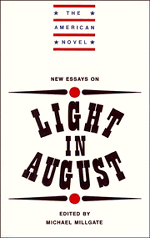Book contents
- Frontmatter
- Contents
- Series Editor's Preface
- 1 Introduction
- 2 “A Novel: Not an Anecdote”: Faulkner's Light in August
- 3 Plots and Counterplots: The Structure of Light in August
- 4 Light in August: The Closed Society and Its Subjects
- 5 The Women of Light in August
- 6 On the Difference between Prevailing and Enduring
- Notes on Contributors
- Selected Bibliography
5 - The Women of Light in August
Published online by Cambridge University Press: 23 November 2009
- Frontmatter
- Contents
- Series Editor's Preface
- 1 Introduction
- 2 “A Novel: Not an Anecdote”: Faulkner's Light in August
- 3 Plots and Counterplots: The Structure of Light in August
- 4 Light in August: The Closed Society and Its Subjects
- 5 The Women of Light in August
- 6 On the Difference between Prevailing and Enduring
- Notes on Contributors
- Selected Bibliography
Summary
ASKED whether he found it easier to create male or female characters, Faulkner told a student at the University of Virginia, “It's much more fun to try to write about women because I think women are marvelous, they're wonderful, and I know very little about them, and so I just - it's much more fun to try to write about women than about men - more difficult, yes.” The mingling of veneration and mystification in Faulkner's response seems to reflect an attitude in which enthusiastic interest is grounded in bemusement. On other occasions, however, he revealed that some of his novels, now among those regarded as his finest, had their inception in visions of individual women: The Sound and the Fury, for example, was inspired by the mental picture of a little girl climbing a pear tree in her muddy drawers to look in at the window of the room where her grandmother lies dead, and Light in August “began with Lena Grove, the idea of the young girl with nothing, pregnant, determined to find her sweetheart. It was - that was out of my admiration for women, for the courage and endurance of women. As I told that story I had to get more and more into it, but that was mainly the story of Lena Grove.” That women in general captured Faulkner's imagination and that specific women, real or imaginary, inspired some of his strongest writing can hardly be doubted, but what does remain in question is how to assess the fictional portraits of women that result.
- Type
- Chapter
- Information
- New Essays on Light in August , pp. 103 - 122Publisher: Cambridge University PressPrint publication year: 1987

